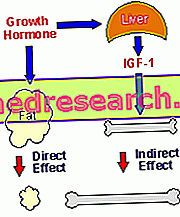The measurement and the evaluation of the head circumference represent, together with other anthropometric parameters (length, weight, thickness of the triceps folds, abdominal and thoracic circumference), an excellent indicator to evaluate the growth of the newborn and the child.
How to measure

The cranial circumference can also be measured during intrauterine life, through echocardiographic examinations and always with the aim of evaluating the correct development of the fetus. In this case, however, we prefer to relate it to the abdominal one.
Normal values
Very often the circumference of the skull is compared to that of the chest; at the moment of birth the cranial one prevails, within the year the two measures are equal and above this age the chest is larger than the head. After birth, in fact, the head circumference grows rapidly (about 11 cm in the first 12 months), after which it increases by only 4 centimeters in the following 9 years. The thoracic circumference, on the other hand, increases more slowly but constantly.
| AVERAGE VALUES | AT BIRTH | ONE YEAR | TWO YEARS |
| Length | 50 cm | 75 cm (males) 74 cm (females) | 88 cm (males) 86 cm (females) |
| Weight | 3.3 kg | 10.55 kg (males) 10.00 kg (females) | 13.05 kg (males) 12.50 kg (females) |
| Head circumference | 35 cm (males) 35 cm (females) | 47 cm (males) 46 cm (females) | 49 cm (males) 48 cm (females) |
In the adult, the head circumference reaches on average:
- the 58 cm in the male (± 3 cm depending on whether the subject is ± tall)
- the 55 cm in the female (± 3 cm depending on whether the subject is ± tall)
Abnormalities of the Head Circumference
macrocephaly
The cranial circumference can overflow into abnormality (macrocephaly) due to a disease known as hydrocephalus (increased cerebrospinal fluid contained in the cerebral ventricles and subarachnoid spaces). Hydrocephalus recognizes various causes and, when it is not treated in time, causes psychomotor retardation, spasticity and seizures. Macrocephalia can also be the consequence of Paget's disease, a chronic degenerative bone disease.
Microcephaly
Pathological values below normal (microcephaly) are an indication of encephalic malformations and mental insufficiency. Also in this case the causes can be different (alcoholism, smoking, syphilis, hormonal alterations - especially thyroid - and metabolic).
We recall that alcohol abuse during pregnancy exerts a heavy teratogenic action and, as such, interferes with the normal development of the fetus causing damage to various organs and functions (fetal alcohol syndrome). Among these, there is also the possibility that the head circumference is lower than the norm, with consequent anomaly in mental development.
Growth percentages
To establish the adequacy of the head circumference, it must be compared with that of other subjects of the same age and sex. To do this it is necessary to have specific tables and graphs, on which are reported the values found in the rest of the population.
For this purpose, the growth curves are widely used, which can be freely consulted at the end of the article (although they refer to the US population, they are also very indicative for the European population).
Even if to an inexperienced eye they can be difficult to interpret, it is enough to remember that each curve designates a percentile, that is the percentage of population that has a lower or higher value than the standard. For example, a child with a head circumference corresponding to the 75th percentile has 75% of peers with lower values and 25% with higher values.
On the basis of these data, cranial circumferences between the 3rd and the 97th percentile are considered in the norm, even if anomalous values do not always have pathological meaning .





